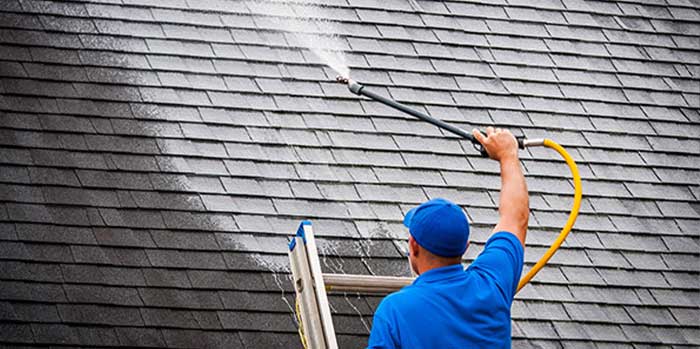What’s Causing Black Streaks? (3 Ways to Remove Algae)
As a homeowner, you want to take pride in your home. But it can be frustrating when your home’s curb appeal is thrown off by black streaking.
Although these dark spots and ugly black streaks may look like dirt, they are algae. Algae, more specifically, gloeocapsa magma, can form a protective dark-colored outer coating that shields it from damaging UV rays, giving it the appearance of dark streaks.
Rescue My Roof has been serving homeowners for over a decade, helping them tackle roof issues from leaks to algae to missing shingles. We’ll walk you through everything you need to know to eliminate those ugly black streaks.
Why do Shingles Get Algae?

Algae spores are airborne. They can be carried by wind and spread quickly from rooftop to rooftop in a neighborhood.
Algae wasn’t always a common problem. Traditionally, asphalt shingles got their name from being made of mainly asphalt – an oil-based product – and felt material. To save money, most shingle manufacturers have switched to shingles containing fillers like fiberglass and limestone, which encourage algae growth.
Additionally, weather is a factor in algae growth. Coastal, warm, and humid climates tend to create the friendliest environments for algae growth. Even parts of the country with cold winter seasons, like Wisconsin, still have problems with roof streaks because they also experience hot and humid summers.
Homes in these algae-prone areas often see algae growth on the home’s north side because it lies in the shade. This shade allows moisture to accumulate and provides the ideal environment for algae growth.
Gutters draining directly onto the roof and overhanging trees also contribute to roof algae. A shady or damp surface also prevents the sun from drying the roof quickly, allowing algae to grow.
Is Roof Algae Harmful?
Algae is not harmful or dangerous alone, but after some time, the algae can cause the protective UV granules that cover shingles to come off.
Fungus – which also travels through the air – can combine with algae already present on your roof and form lichen. Lichen feeds off of both the algae and the shingle filler. Unlike algae, lichen can develop roots, which makes it harder to remove than algae alone.
3 Ways to Get Rid of Black Streaks On Your Roof
A simple roof cleaning can easily remove roof algae.
Here are three steps you can follow:
1. Don’t Use A Pressure Washer

While cleaning your roof, never use a pressure washer.
Asphalt shingles have a top coating made of granules. Granules are your roof’s first line of defense against moisture.
When you use high pressure to wash your roof, you may wash away some of those essential granules or even cause some shingles to lift.
If you need a pressure washer, use it on its lowest setting. Even then, we don’t recommend a power washer as a first resort for roof cleaning.
2. Use A Bleach and Water Solution
If you want a clean roof on a budget, there’s still a way to clean your roof without a pressure washer.
Cover all your vegetation and landscaping, wear protective clothing and glasses, and check your shingle manufacturer’s website for cleaning recommendations. After, you can clean your roof with a bleach and water solution.
Here’s what Bob Villa recommends:
- 1 cup of trisodium phosphate (found at a hardware store)
- 1 gallon of bleach
- 5 gallons of water
Spray your roof with this solution from top to bottom, allowing it to soak in for 15-20 minutes before rinsing.
3. Hiring a Professional to Clean Your Roof

We don’t blame you if you don’t want to climb on your roof to clean it. Many homeowners are in the same boat. But there’s always another option: hiring a professional for a roof cleaning service.
Roofing contractors use algaecides to ensure those pesky black stains are gone and unlikely to return. The result is a beautifully restored roof and little work for you.
How to Prevent Black Roof Stains
We’ve covered all the ways to clean your roof, from DIY bleach solutions to hiring a professional, but is there a way to prevent algae growth?
Trimming excess tree branches, cleaning off roof debris, and keeping your gutters clean can help keep algae growth at bay. Any standing water or debris can be a breeding ground for algae we want to avoid.
Additionally, you can install a copper or zinc strip along the peak of your roof. The metals contain algae-killing molecules. When water washes down your roof, the molecules can kill any algae lurking around.
You can learn more about roofs and algae growth with “Roof Staining, Algae Growth, and More” and “The Top 5 Problems With Asphalt Roofs.”
Are you experiencing problems with algae growth and staining on your roof? Rescue My Roof has over a decade of experience treating algae and roof stains. You can contact us today to get a free estimate.


